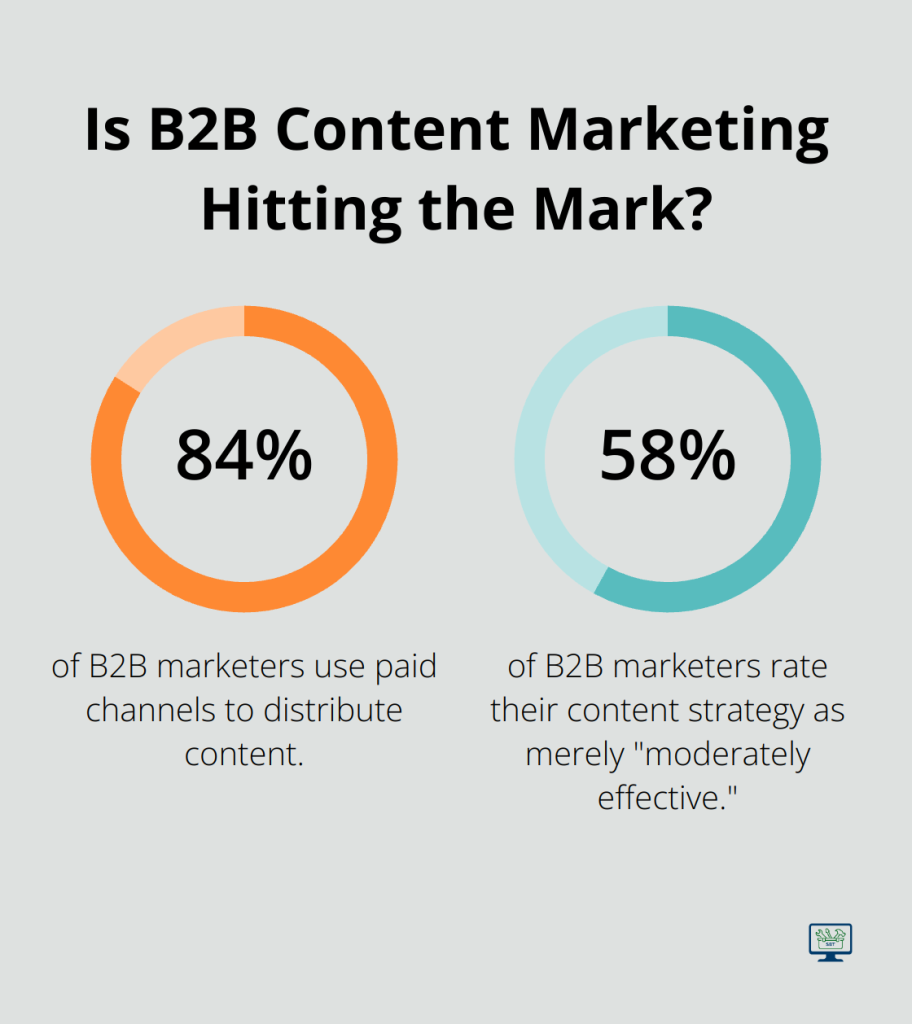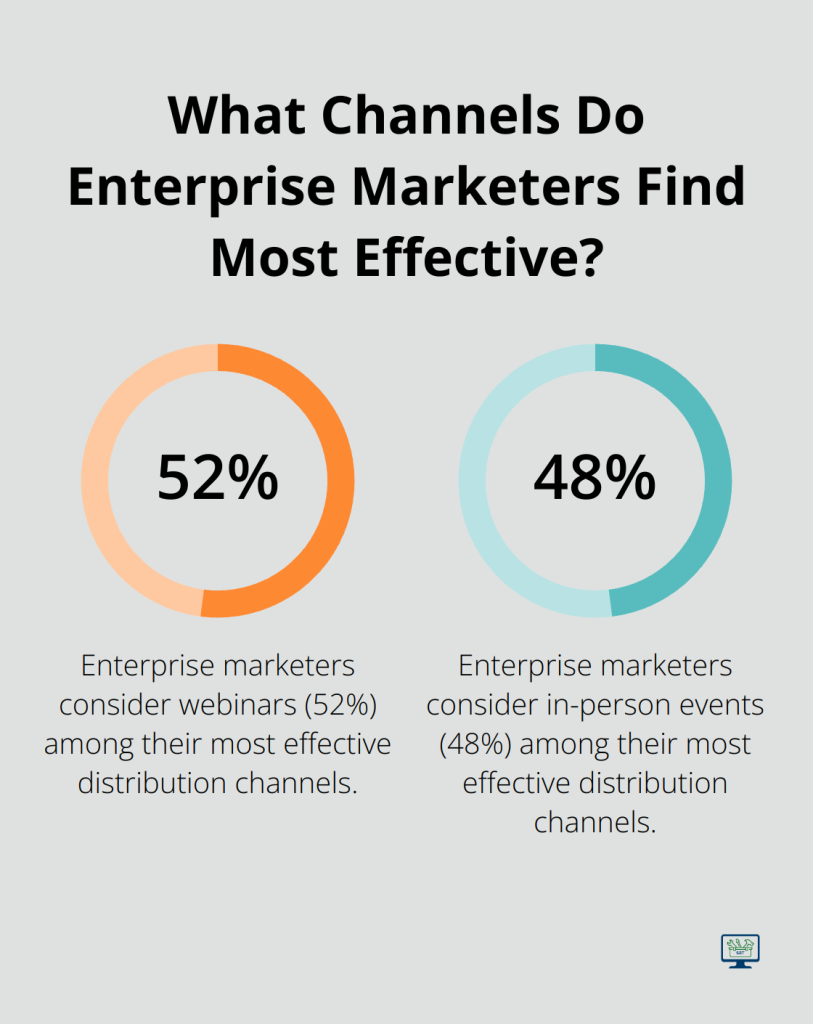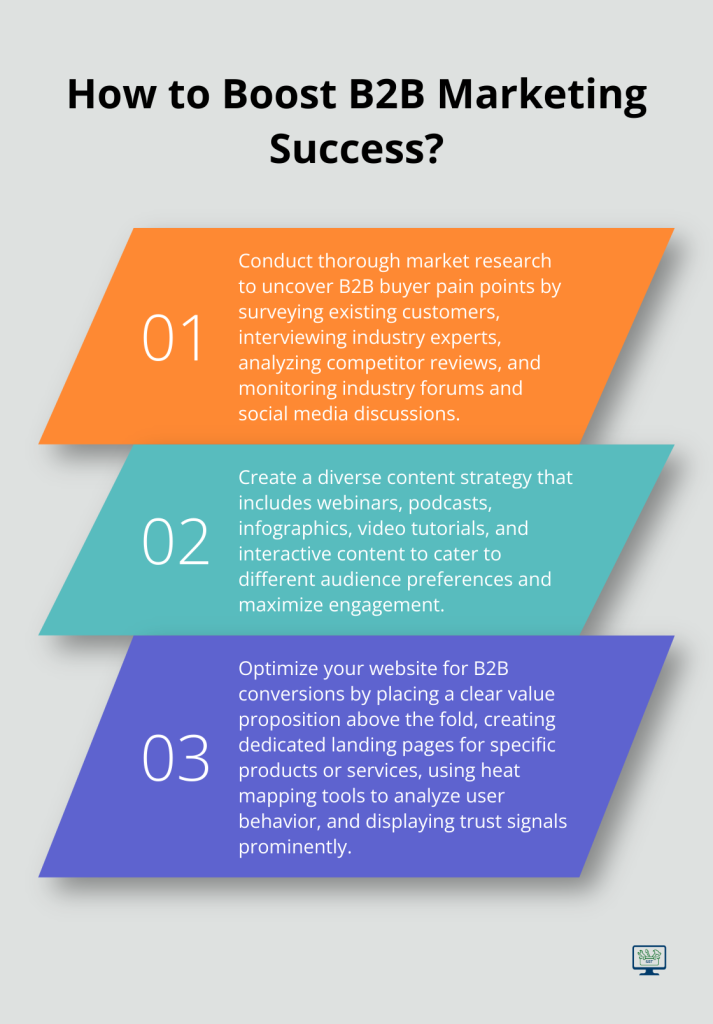B2B marketing has evolved rapidly in recent years, demanding innovative strategies to stay competitive. At SmallBizToolbox, we’ve seen firsthand how effective business-to-business marketing strategies can transform companies’ growth trajectories.
This post will guide you through proven tactics to elevate your B2B marketing game and drive measurable results. From understanding your audience to leveraging digital channels, we’ll cover the essential elements of a successful B2B marketing approach.
Who Are Your B2B Buyers
Pinpointing Decision Makers
B2B sales rarely involve a single decision maker. A Gartner study reveals that the typical buying group for a complex B2B solution involves six to ten decision makers. Each individual brings a unique perspective and set of information they have gathered to the table.

To identify these key players, map out the organizational structure of your target companies. Focus on roles such as Chief Technology Officers, Procurement Managers, or Department Heads. LinkedIn offers a wealth of information for this purpose. Once you’ve identified potential decision makers, customize your outreach to address their specific concerns and goals.
Uncovering Pain Points
B2B buyers seek solutions to their problems, not just products or services. A recent study found that 55% of buyers now rely more on content to research and make purchasing decisions than they did a year ago.
To uncover these pain points, conduct thorough market research. This can include:
- Surveys of existing customers
- Interviews with industry experts
- Analysis of competitor reviews
- Monitoring of industry forums and social media discussions
Use this information to create detailed buyer personas that outline not just demographics, but also challenges, goals, and preferred communication channels.
Navigating the B2B Buyer’s Journey
The B2B buyer’s journey extends longer and involves more complexity than its B2C counterpart. Forrester’s 2021 B2B Buying Study reveals how buyers responded to the new norm of being mostly virtual while seeking information about providers.
This journey often includes:
- Awareness: The buyer recognizes a problem or opportunity.
- Consideration: They define the problem and research potential solutions.
- Decision: The buyer chooses a solution and selects a vendor.
To guide buyers effectively through this journey, create content that addresses their needs at each stage. For example, blog posts and infographics work well for the awareness stage, while case studies and product comparisons prove more effective during the consideration phase.
The millennial factor plays a significant role in B2B buying decisions. This demographic prefers digital interactions and values authenticity and social responsibility in the brands they choose.
A thorough understanding of your B2B audience (from decision makers to pain points to buying journey) equips you to create targeted, effective marketing strategies. These strategies will resonate with your potential customers and drive conversions. Now, let’s explore how to leverage content marketing to capitalize on this understanding and achieve B2B success.
How to Create Impactful B2B Content
Content marketing stands as a cornerstone of successful B2B strategies. Well-crafted content drives engagement, builds trust, and leads to conversions. Let’s explore how to create and distribute content that resonates with your B2B audience.
Craft Value-Driven Content
The key to effective B2B content is to provide genuine value to your audience. 84% of B2B marketers use paid channels to distribute content. To stand out, address specific pain points and offer actionable solutions.

Start with thorough research on your industry and target audience. Use tools like Google Trends, industry reports, and customer feedback to identify trending topics and common challenges. Then, create content that directly addresses these issues, offering practical advice and insights.
For example, if you target CFOs in the manufacturing sector, create a detailed guide on cost-saving strategies specific to their industry. Include real-world examples, data-driven insights, and step-by-step instructions to maximize the value of your content.
Diversify Content Formats
Written content remains important, but diversifying your content formats helps you reach a wider audience and cater to different preferences. HubSpot reports on trends, opportunities, and challenges brands will face this year, based on data from 1,700+ global B2B and B2C marketers.
Try to incorporate the following formats into your content strategy:
- Webinars: Host live or on-demand webinars featuring industry experts to discuss relevant topics.
- Podcasts: Launch a podcast series discussing industry trends and interviewing thought leaders.
- Infographics: Present complex data in visually appealing, easy-to-digest formats.
- Video tutorials: Create how-to videos demonstrating your product or service in action.
- Interactive content: Develop quizzes, calculators, or assessments that provide personalized insights.
Implement a Strategic Distribution Plan
Creating great content is only half the battle. To maximize its impact, you need a robust distribution strategy. 58% of B2B marketers rate their content strategy as merely “moderately effective.”
Tailor your distribution approach to your target audience’s preferences. LinkedIn often proves the most effective platform for B2B content.
Email marketing remains a powerful tool for B2B content distribution. Segment your email list based on industry, job role, or stage in the buyer’s journey to ensure your content reaches the right people at the right time.
Don’t overlook the power of employee advocacy. Encourage your team to share company content on their personal professional networks. This can significantly expand your reach and lend credibility to your message.
Consider repurposing your content across different formats and channels. A single piece of content can transform into multiple assets, maximizing your return on investment and reaching a broader audience.
Consistency plays a key role in establishing your brand as a trusted industry resource. Regularly publish high-quality content to maintain engagement and build authority. As we move forward, let’s explore how to harness the power of digital marketing channels to amplify your B2B marketing efforts and drive measurable results.
How to Maximize Digital Channels for B2B Success
Optimize Your Website for Conversions
Your website often serves as the first point of contact for potential B2B clients. Forrester predicts that 2025 will be a year of consumer contradictions, with consumers behaving in opposing ways. This highlights the importance of understanding your audience and optimizing your website accordingly.

To optimize your website for B2B conversions:
- Place a clear and compelling value proposition above the fold on your homepage.
- Create dedicated landing pages for specific products or services, tailored to different buyer personas.
- Use heat mapping tools to analyze user behavior and optimize page layouts.
- Display trust signals (client logos, case studies, industry certifications) prominently.
- Ensure your site works well on mobile devices – 50% of B2B search queries now occur on smartphones.
A/B testing proves essential for continuous improvement. Test different headlines, call-to-action buttons, and form layouts to identify what resonates best with your audience.
Leverage Social Media for B2B Engagement
While many associate social media primarily with B2C marketing, it holds equal power for B2B. LinkedIn is 277% more effective at lead generation than other social media sites, according to an Oktopost study.
To use social media effectively:
- Share thought leadership content regularly to establish industry authority.
- Participate in relevant industry groups and discussions to build relationships.
- Use LinkedIn’s Sales Navigator tool to identify and connect with key decision-makers.
- Experiment with LinkedIn’s sponsored content to reach a wider, yet targeted audience.
- Utilize other platforms – Twitter for real-time industry updates, YouTube for detailed product demonstrations.
Social media thrives on relationship-building, not just broadcasting messages. Engage with your followers, respond to comments, and join industry conversations to maximize your impact.
Implement Targeted Email Marketing Campaigns
Despite the rise of new digital channels, email remains a cornerstone of effective B2B marketing. According to the Content Marketing Institute, enterprise marketers consider webinars (52%) and in-person events (48%) among their most effective distribution channels.
To create impactful email campaigns:
- Segment your email list based on industry, company size, or stage in the buying journey.
- Personalize content beyond just using the recipient’s name – tailor the message to their specific challenges and interests.
- Use automation to send timely, relevant emails based on user behavior or milestones in the sales process.
- Implement a lead scoring system to identify when prospects become ready for direct sales outreach.
- Clean your email list regularly to maintain high deliverability rates and engagement.
Tools like Mailchimp or HubSpot can help manage your email marketing efforts effectively. However, businesses seeking a more comprehensive solution that integrates email marketing with other digital marketing tools might consider platforms tailored for small businesses in Australia, which offer robust solutions to attract and retain customers.
Final Thoughts
Effective business-to-business marketing strategies drive success in today’s competitive landscape. Understanding your audience, creating valuable content, and leveraging digital channels enhance your B2B marketing approach. Continuous adaptation and improvement remain vital as the B2B marketing world evolves rapidly.

SmallBizToolbox offers a comprehensive suite of tools designed to help Australian businesses grow and succeed. Our platform provides support to elevate your marketing efforts, from AI-driven content creation to SEO optimization and social media aids. We understand the challenges small businesses face in implementing effective B2B marketing strategies.
Take the first step to transform your B2B marketing strategy today. Visit SmallBizToolbox to explore how our tools can help you achieve your business goals. Success in B2B marketing requires continuous refinement and adaptation to meet the evolving needs of your audience.
How useful was this Resource?
Click on a star to rate it!
Average rating 0 / 5. Vote count: 0
No votes so far! Be the first to rate this post.
We are sorry that this post was not useful for you!
Let us improve this Resource!
Tell us how we can improve this Resource?




